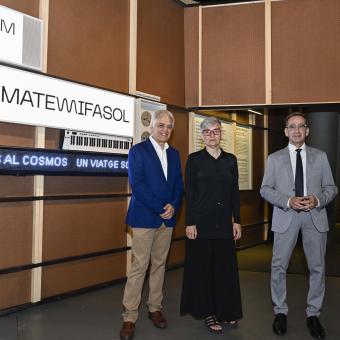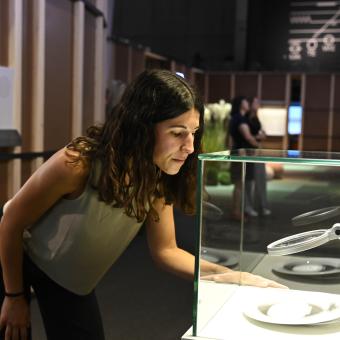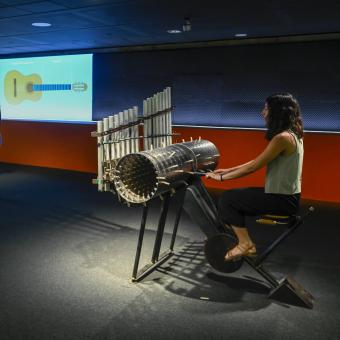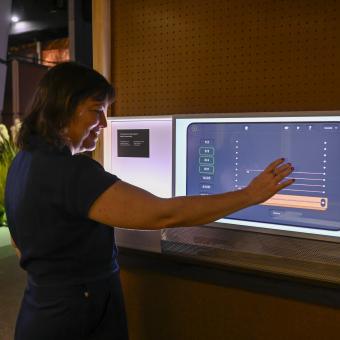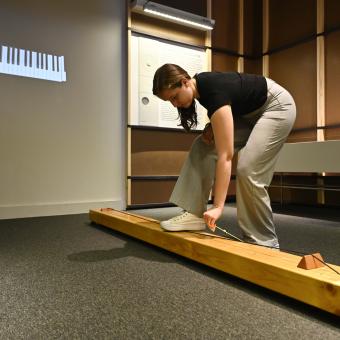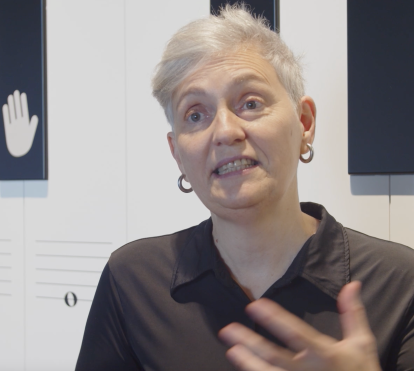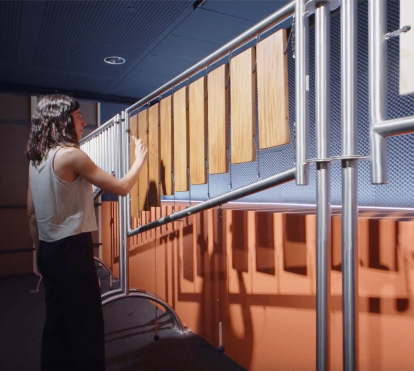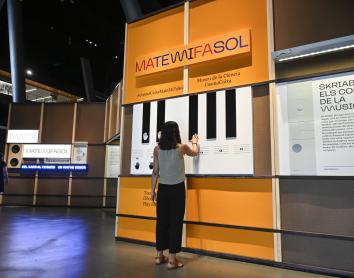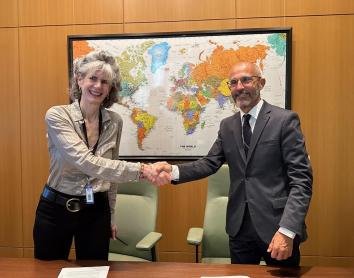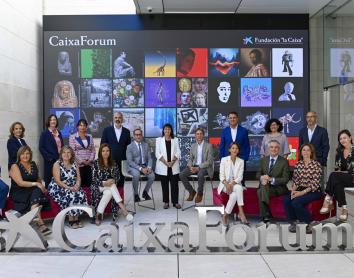
CosmoCaixa buzzes with the link between music and mathematics in a new interactive exhibition
10.07.24
7 minutes readMusic is feeling and emotion, but behind the sensations it evokes in us lies the rationality of mathematics. This is the central idea behind MateMiFaSol. A sound journey from chaos to the cosmos, an exhibition that traces the history of sounds from the Big Bang to the present day. The exhibition uses its eminently interactive nature to help visitors understand the links between the two disciplines by visualising the waves generated by a vibrating string, imitating the timbre of different instruments or playing with notes, rhythms and timbres to create a harmonious sound.
The director of the CosmoCaixa Science Museum, Valentí Farràs, along with the exhibition’s scientific advisors, Magda Polo and Carlos Calderón, presented this Tuesday MateMiFaSol. A sound journey from chaos to the cosmos, a new exhibition that explores the indestructible link between music and mathematics, which can be seen at CosmoCaixa until 12 January 2025.
Mathematics is present in all aspects of music, from the physics of sound to the construction of instruments, from rhythmic patterns to tonal harmony. It is a close relationship that visitors will be able to understand better thanks to this in-house exhibition by the ”la Caixa” Foundation. MateMiFaSol is an interactive exhibition with plenty of music and lots of audiovisual material that invites visitors to reflect through practical experiences and accompanies them in their discoveries. It is an exhibition that questions, explains, suggests, discovers and makes us see music and mathematics as two equivalent, rational and beautiful languages.
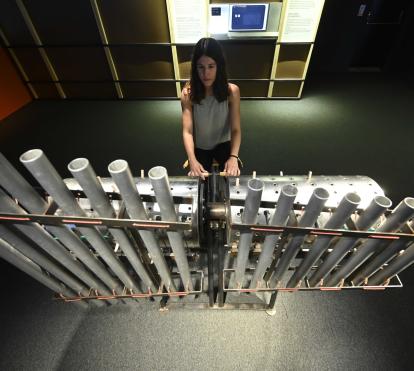
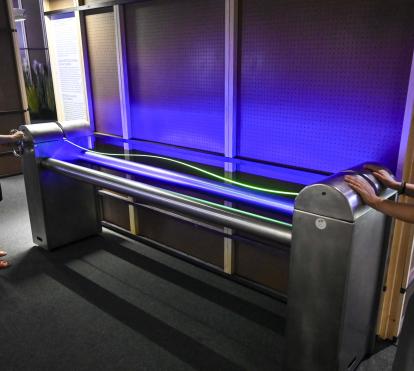
Some thirty interactive modules and fifteen audiovisuals allow the public to get to know music from the inside and to discover how sound is transmitted, how we hear it and the techniques used by composers to write music, with variations and transformations that have a mathematical basis. Not only classical music or contemporary creations are based on mathematics: pop music has the same foundation.
The exhibition is based on a scale of seven concepts inspired by the seven notes of the stave. A colour corresponds to each of them, in line with the ideas of the composer Aleksandr Scriabin in his symphony Prometheus (1910). Like Prometheus, who stole fire from the gods, the philosopher Pythagoras stole the secret of music from them: he experimented with a new instrument, the monochord, which enabled him to identify and define musical intervals. His research made it possible to study music and define the laws that articulate it.
The relationship between music and mathematics cannot be analysed without considering physics, history, philosophy, biology, medicine and aesthetics, disciplines that are all present in the exhibition. What must the Big Bang have sounded like? How does the ear work? What are melody, tone, harmonics, timbre, resonance and rhythm? Science is behind all these concepts.

The exhibition delves into the mathematical foundations of beauty related to the golden ratio or Mozart’s dice, a game of combinations that allows an infinite number of compositions to be obtained, all of them beautiful. And it invites us to discover the beauty of mathematics, which is the abstract version of music.
The final section, dedicated to the music of the cosmos, introduces a metaphysical dimension to the exhibition. The universe is a mystery. To capture its complexity and beauty, based on the work of the 16th century astronomer and mathematician Johannes Kepler, visitors can enjoy a cosmic symphony in an immersive, high-impact room.
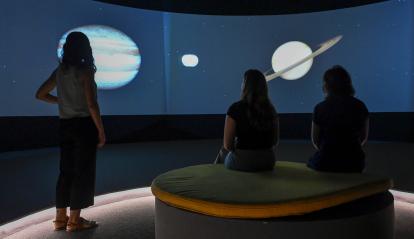
The exhibition has received scientific advice from Magda Polo, full professor at the History of Art Department of the Universitat de Barcelona and lecturer in Aesthetics and Theory of Art, History of Music and Philosophy of Music, and Carlos Calderón, musician, music communicator and architect, specialising in the monochord and the “music of the spheres”. The exhibition has also benefited from the participation of the artist Michael Bradke, who has 25 years’ experience in creating interactive elements to explain music in museums, and who has provided a dozen interactive elements of great beauty and museographic power that reveal the intense relationship between music and mathematics.
MateMiFaSol: beyond the exhibition hall
This exhibition will be complemented by a large number of activities that will allow visitors to delve deeper into the subject, starting with an inaugural concert by the pianist and mathematician Laura Farré Rozada, who will offer a sonic journey that follows the same line of argument as the exhibition: from silence, we will pass through chaos, sound and music until we reach the cosmos. The programme includes pieces by Dimitar Nenov, Gayane Chebotarian and Claude Debussy, a composer who appears in the exhibition and who stated that “mathematics is the basis of music”. The performance will be enhanced by the visual accompaniment of creations by Alba G. Corral, a visualist and computer engineer known for integrating coding and crafting in collaboration with musicians in real time.
Complementary activities will also bring us the voices of professionals in these fields in the form of conferences. Among them, within the framework of the Greats of Science series, “Symmetry: from geometry to music”, featuring Marcus du Sautoy, PhD in Mathematics and professor at the University of Oxford. Meanwhile, the talk “The score of the cosmos, the music of the stars” will bring us closer to research by the Instituto de Astrofísica de Canarias (IAC) on the way in which galaxies vibrate according to a rhythmic pattern, like any musical instrument, and are also arranged in perfect harmony with each other, like the families of instruments in an orchestra. The thereminist Lydia Kavina, IAC researcher Terence John Mahoney and filmmaker Juanma Betancort, who together are making the documentary La partitura del cosmos [The Score of the Cosmos] will introduce the audience to the music of the stars.
Continuing in the field of conferences, the Live Talk “Mathematical music” will be given by the physicist, music lover, award-winning mathematician and UPC lecturer Clara Prats, in which questions such as whether by mastering the language of music we also master a part of mathematical language, or whether listening to a symphony also means perceiving the rhythm and beauty of mathematics, will be resolved via streaming; and two talks with the pianist and mathematician Laura Farré Rozada, one on how mathematics can be used to distort our perception and the other on the multiple musical facets of chaos theory, from its most basic foundations to its creative potential. In addition, as part of the new programme Science to open the melon, aimed at an adult audience, there will be a participatory experience with the engineer, pianist and science communicator Gonzalo Villar, accompanied by the Big Van Ciencia monologists.
Activities for families have also been prepared, such as the workshops “Soplar y hacer ciencia” [Blow and do science], in which participants will learn about concepts such as sound waves, the production and propagation of sound, timbre, frequency and amplitude, in order to discover all the secrets of instruments; Sonidos teledirigidos [Remote-controlled sounds], where children will be able to explore how sound is produced and the emotions it evokes, and A ritmo de números y cifras [At the rhythm of numbers and figures], in which participants will play surprising mathematical games, learn how to calculate with an abacus and send coded messages to their classmates. And part of the Christmas programme will also feature the show La sandalia de Pitágoras [Pythagoras’s Sandal], which presents Pythagoras (Pi to the museum’s audience), a character who lives in a village where mathematics is mixed with music, mythological goddesses with mobiles, jazz bands with popular festivals...
The exhibition will also be complemented by guided tours, and family and educational visits which will provide an opportunity to explore its content with the help of an educator.
